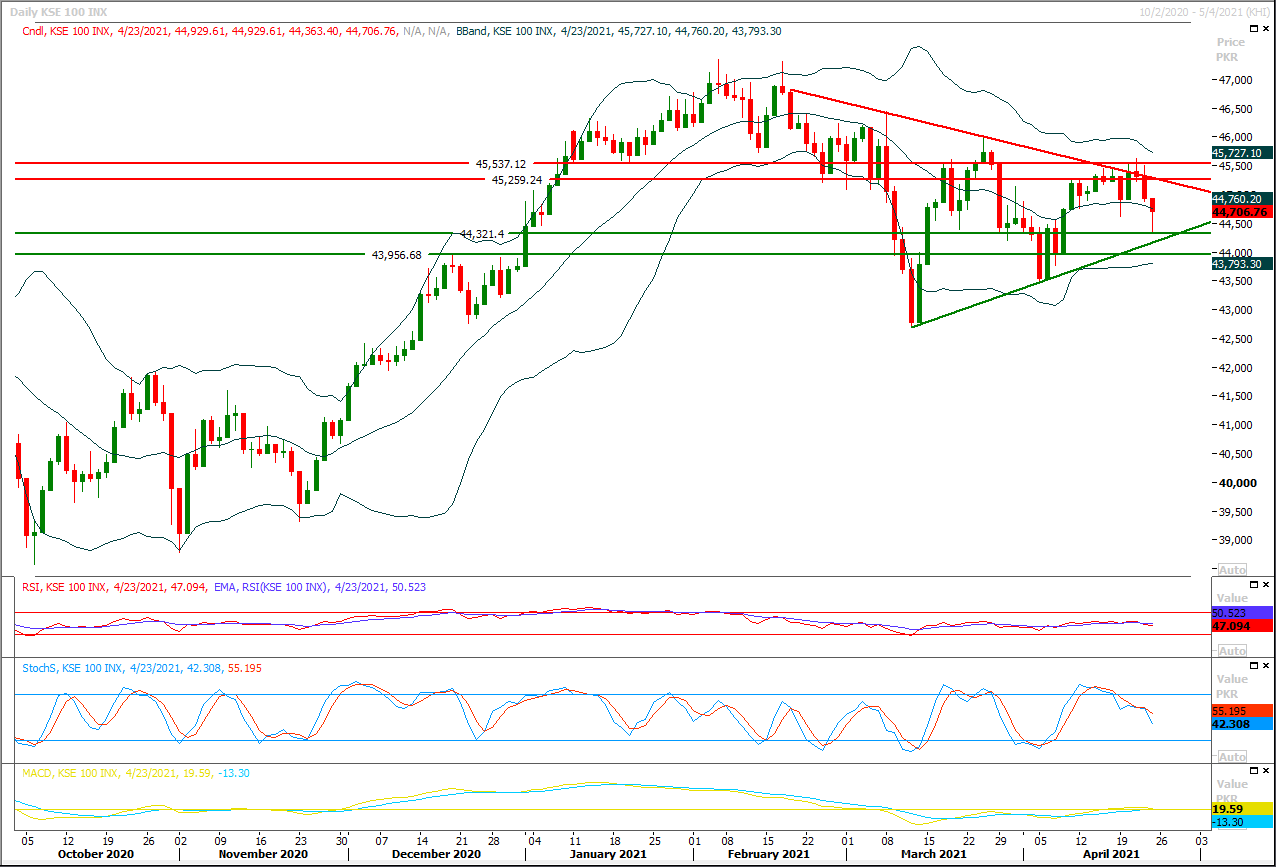Technical Overview
The Benchmark KSE100 index is being caged in a triangle on daily chart and had bounced back after getting support from a strong horizontal supportive region along with supportive trend line of this triangle during last trading session. As of now it’s expected that index would try to continue its pullback towards 45,000pts where it’s being capped by a strong horizontal resistant region while breakout above this region would call for 45,200pts and 45,500pts. Overall it needs to stay cautious because current triangle is being tightened and index needs to give a breakout of either side therefore it’s recommended to adopt swing trading with strict stop loss. Currently daily momentum indicators are still in bearish mode therefore it can be said that index would not enter into bullish zone until it would not succeed in closing above 45,500pts. While in case of rejection from its resistant regions index would try to find support initially at 44,500pts which would be followed by 44,300pts and 43,900pts. Index would enter bearish zone if it would succeed in closing below 44,000pts this time therefore it’s recommended to stay cautious and avoid initiating new long positions for short to mid-term trading

Regional Markets
Asian markets shake off U.S. tax worries to push higher
Asian shares rose on Friday after the European Central Bank left policy unchanged, extending a rebound following a sharp selloff earlier in the week, but gains were capped as investors considered the impact of a possible U.S. capital gains tax hike. The ECB's decision to keep copious stimulus flowing came despite its prediction of a strong rebound in the euro zone economy from mid-year as COVID-19 infections are brought under control. In Asia on Friday morning MSCI's broadest index of Asia-Pacific shares outside Japan shook off early small losses to rise 0.1%. Chinese blue-chip shares rose 0.33%, Hong Kong's Hang Seng (.HSI) rose 0.55% and Seoul's Kospi (.KS11) added 0.16%. Japan's Nikkei stock index slid 0.68%.
Read More...
Business News
Palm oil imports increase 34.83pc to $1.86 billion in 3 quarters
The palm oil imports increased by 34.83 per cent during the first three quarters of the current fiscal year against the imports of the same period of last year. The palm oil imports during July-March (2020-21) were recorded at $1860.935 million against the imports of $1380.245 million during July-March (2019-20), showing increase of 34.86 per cent, according to latest data of Pakistan Bureau of Statistics (PBS). In terms of quantity, Pakistan imported 2,443,293 metric tons of palm oil during the period under review as compared to the imports of 2,277,022 metric tons last year, showing increase of 7.3 per cent. On the other hand, the soya bean oil imports also increased by 6.72 per cent by going up from $45.286 million last year to $48.327 during the current fiscal year. in terms of quantity, the soya bean oil imports increased from 65,943 metric tons to 72,776 metric tons, showing an increase of 10.36 per cent..
Read More...
Punjab seeks $500m WB loan for rural water supply, sanitation
The Punjab government is seeking $500 million from the World Bank to provide water to rural areas and address sanitation problems in 16 districts and tehsils to serve a population of 6.65 million in the province. Interventions will include governance and institutional reforms, investments for both water supply and sanitation, strengthening monitoring through use of information technology, capacity development and behaviour change. A World Bank document says the project will target districts in Punjab that are the poorest and have the worst outcomes on child stunting, access to and quality of sanitation infrastructure, and bacterial contamination of drinking water at source and at point of use. Overall, the project is expected to cover about 2,000 villages, main settlements and 8,500 small settlements in Khushab, Mianwali, Sargodha, Chakwal, Bhakkar, Pakpattan, Chiniot, Jhang, Rajanpur, Rahim Yar Khan, Dera Ghazi Khan, Lodhran, Bahawalpur, Muzaffargarh, Bahawalnagar and Multan districts.These districts are the worst off in their region. Overall, access to water and sanitation and child health indicators are much worse in south Punjab as compared to the averages for central and northern Punjab.y.
Read More...
National Savings working on ad hoc basis for years
Pakistan’s largest financial institution with over Rs3.4 trillion portfolio, the state-run National Savings, has been without a regular head for more than two-and-a-half years and continues to operate on an ad hoc basis. Finance ministry officials told Dawn that the post had fallen vacant on September 1, 2018 when its director general Zafar Masood, who had been hired by the previous government from the private sector, was shown the door. Since then, it has been looked after by junior officers or outsiders on an acting charge basis. On Mr Masood’s exit, the Ministry of Finance had given the “look after charge” of the grade-21 position to Mohammad Khalil, a grade-20 officer, initially for three months. Officials said the acting charge for three months was approved by Prime Minister Imran Khan, who also approved its extension for three more months till March 2019. But the finance ministry gave the “look after charge” to Mr Khalil for an indefinite period till the appointment of another director general of Central Directorate of National Savings (CDNS). “As a result, a huge national department is running on a casual basis for the last two years and a half,” said a senior official, adding the private sector would never leave such a top position of their financial institutions without a professional head even for a day..
Read More...
Circular debt to remain over Rs1.1tr by 2023
Despite repeated tariff increases, buying out several old independent power plants (IPPs), fuel conversions, tax rationalisations and timely subsidy payments over the next two years, the power sector circular debt would stay above Rs1.1 trillion by end of fiscal year 2023 against about Rs2.55tr estimated at present. But not doing these ‘surgical actions’ is not an option. Without these measures, the circular debt is projected to reach Rs4.7tr by end of FY2023. With some efficiency improvements in terms of five per cent increase in recovery and less than one per cent in technical losses, the circular debt is projected at Rs4.4tr by 2023, but it would be the “tariff rebasings and quarterly adjustments” that will move the needle down to about Rs3.5tr — almost Rs1.1tr in two years.
Read More...


0 Comments
No comments yet. Be the first to comment!
Please log in to leave a comment.